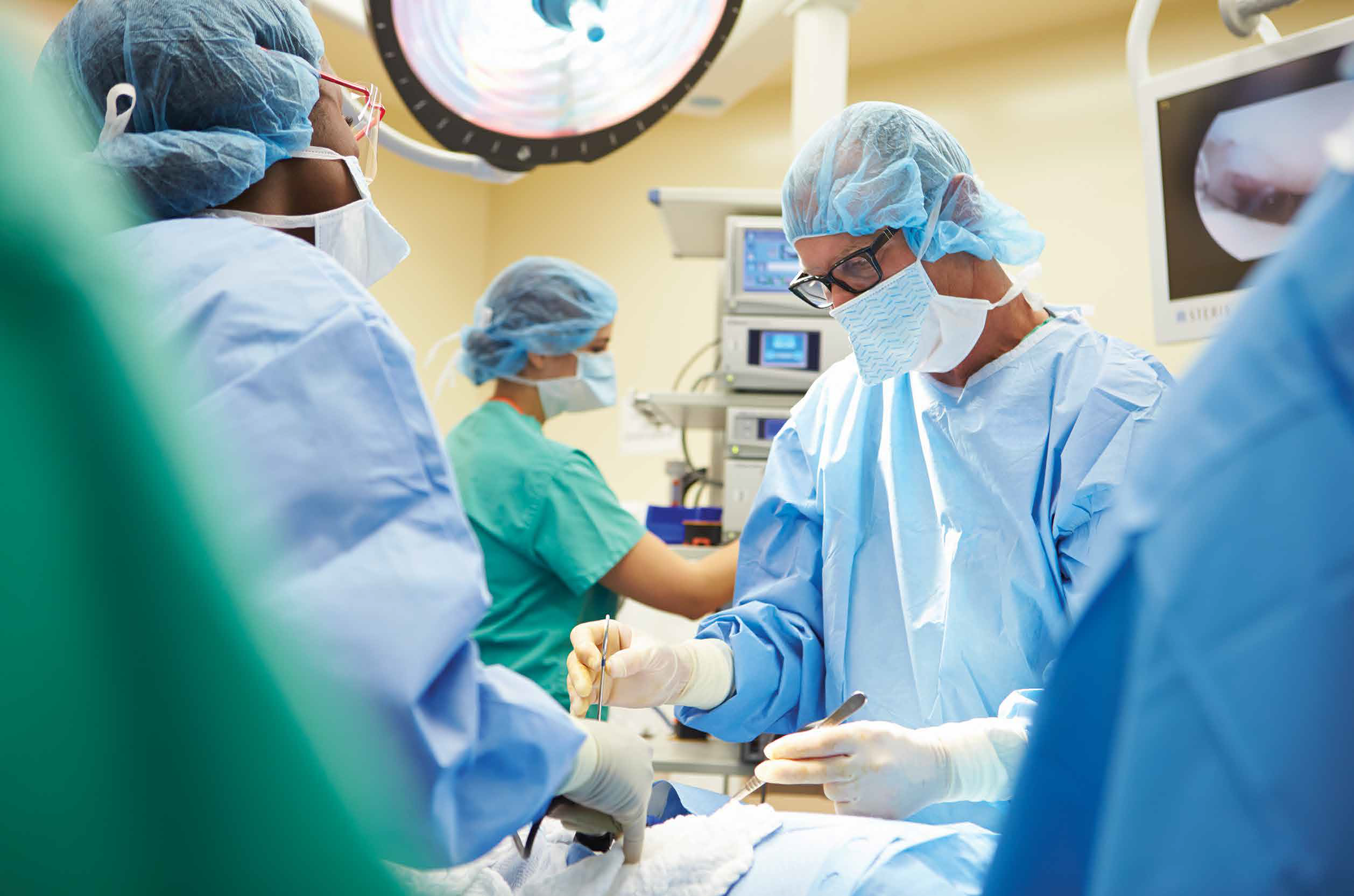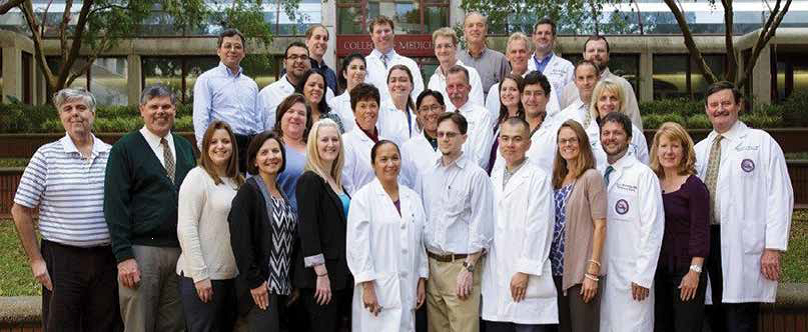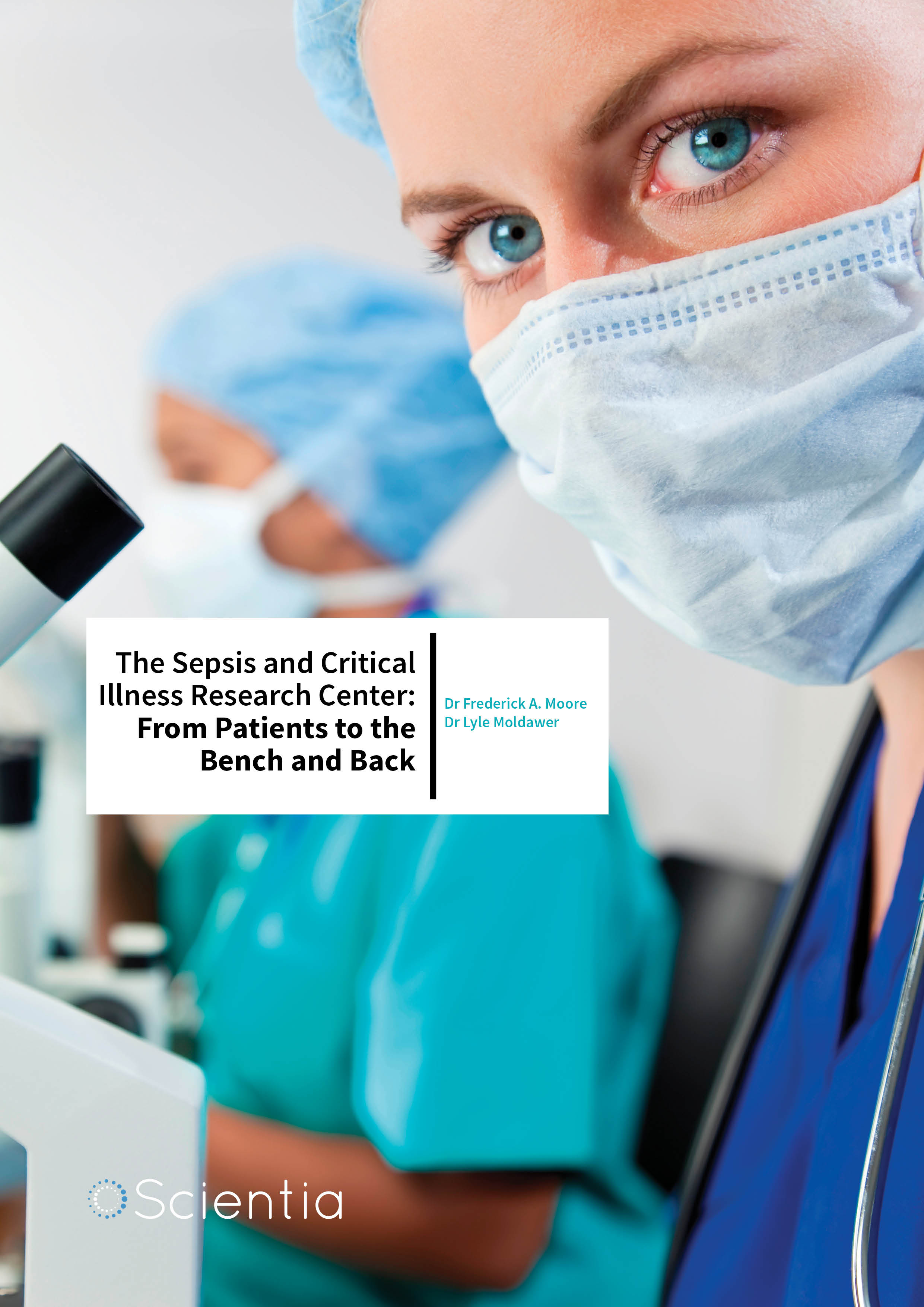Dr Frederick A. Moore & Dr Lyle Moldawer – The Sepsis And Critical Illness Research Center: From Patients To The Bench And Back
By taking a complex disease and breaking it down to its basics, The Sepsis and Critical Illness Research Center (SCIRC) has evolved into an organisation with the unique ability to tackle sepsis from biological, clinical and translational standpoints.
What is Sepsis?
Sepsis is a serious complication that arises from the body’s adverse response to a prevailing infection. In the past, sepsis often led to multiple organ failure and early death, but due to improvements in treatments and surgical techniques, patient survival has increased. However, longterm mortality and inadequate functional recovery remain a significant burden. Patients – especially the elderly – who survive episodes of sepsis are still discharged to long-term acute care and skilled nursing facilities, and rarely rehabilitate completely. Therefore, although in-hospital mortality has decreased, the burden of care has simply been shifted to other facilities. Many patients in surgical Intensive Care Units (ICU) that are diagnosed with sepsis present symptoms that progress towards morbid long-term outcomes, a phenotype that is now referred to as Persistent Inflammation, Immunosuppression and Catabolism Syndrome (PICS).
At least a million people in the US are diagnosed with sepsis every year, out of which 30–50% eventually die. To put this into perspective, these figures imply that the mortality rate of sepsis is higher than that of prostate cancer, breast cancer and AIDS combined. Moreover, the Agency for Healthcare Research and Quality has identified sepsis to be the most expensive condition treated in US hospitals. Hence, a full understanding of the causes of sepsis, its clinical presentations and the response to treatment is urgently required.
From Idea to Inception: The Sepsis and Critical Illness Research Center
The Sepsis and Critical Illness Research Center (SCIRC), the first of its kind in the US, was set up in 2014 with the mission to attack sepsis from all angles. The Center aims to do so by undertaking basic research to understand the manifestations of the disease, improving patient care through the use of advanced technology, educating healthcare professionals on best practices, providing community access to relevant information, and finally, by engaging in external fundraising and advocacy initiatives. The Center’s multiple collaborations with universities and healthcare entities, such as UF Health Shands Hospital, combined with a multi-disciplinary approach to research (combining basic, clinical and translational research) offers a unique opportunity to understand and tackle this complex disease.
The SCIRC was conceptualised by Dr Frederick Moore, who was hired in 2011 to head acute care surgery in the University of Florida (UF) Health Shands hospital and by Dr Lyle Moldawer, Professor and Vice-Chair of Research in the Department of Surgery at UF. They received a $12 million, five-year P50 grant from the National Institute of General Medical Sciences (NIGMS), for the purpose of creating a regional and national specialised organisation dedicated to sepsis research and treatment. Dr Moore brought with him expertise in creating translational research teams studying multiple organ failure, while Dr Moldawer is a world renowned expert in the basic immunological events that occur before, during and after sepsis. Briefly, a severe septic insult simultaneously results in both pro-inflammation (Systemic Inflammatory Response Syndrome) and anti-inflammation (Compensatory Antiinflammatory Response Syndrome). If this response is not well managed, patients fail to return to immunologic homeostasis and many progress into chronic critical illness. Dr Moore and Dr Moldawer were the first to coin the term PICS to describe the underlying pathophysiology of persistent low grade inflammation, immunosuppression and catabolism that causes the progression of disease into a state that leads to long stays in the ICU, followed by dismal long-term outcomes. By understanding more about the causes of sepsis, its incidence and the progression of PICS, the Center hopes to reduce the burden on the healthcare system and to significantly improve the quality of life and long-term survival outcomes of patients.
 The SCIRC’s origins date back to 2004, when the UF Health Shands hospital hired Dr Larry Lottenberg to establish a muchneeded Level 1 trauma facility for North Central Florida. One year later, a new South Tower was constructed in the Shands hospital with a state-of-the-art trauma and critical facilities. At the same time, over 50% of the Department of Surgery’s NIH funding was with Dr Lyle Moldawer, who was already conducting innovative sepsis and trauma basic research. The watershed event happened in 2011, when Dr Frederick Moore was recruited, with the purpose of building a clinical/translational research program dedicated to sepsis and trauma. A multidisciplinary science team was soon put together, which involved collaborations between the Department of Surgery and Anaesthesiology, the Department of Molecular Genetics and Microbiology, the Institute on Aging and the Division of Nephrology. The surgical ICUs were reorganised to perform multidisciplinary translational research. The team went on to establish hospital-wide sepsis surveillance and treatment bundles, and incorporated the use of Computerised Clinical Decision Support (CCDS) systems in the surgical ICUs. They showed that the implementation of sepsis screening and CCDS reduced mortality of severe sepsis from 35% to 14%. In 2013, the Institute on Aging also moved into two new buildings. With over 40,000 square feet of office and clinical space, the institute serves as a perfect base for discharged patients to return for cognitive and functional testing.
The SCIRC’s origins date back to 2004, when the UF Health Shands hospital hired Dr Larry Lottenberg to establish a muchneeded Level 1 trauma facility for North Central Florida. One year later, a new South Tower was constructed in the Shands hospital with a state-of-the-art trauma and critical facilities. At the same time, over 50% of the Department of Surgery’s NIH funding was with Dr Lyle Moldawer, who was already conducting innovative sepsis and trauma basic research. The watershed event happened in 2011, when Dr Frederick Moore was recruited, with the purpose of building a clinical/translational research program dedicated to sepsis and trauma. A multidisciplinary science team was soon put together, which involved collaborations between the Department of Surgery and Anaesthesiology, the Department of Molecular Genetics and Microbiology, the Institute on Aging and the Division of Nephrology. The surgical ICUs were reorganised to perform multidisciplinary translational research. The team went on to establish hospital-wide sepsis surveillance and treatment bundles, and incorporated the use of Computerised Clinical Decision Support (CCDS) systems in the surgical ICUs. They showed that the implementation of sepsis screening and CCDS reduced mortality of severe sepsis from 35% to 14%. In 2013, the Institute on Aging also moved into two new buildings. With over 40,000 square feet of office and clinical space, the institute serves as a perfect base for discharged patients to return for cognitive and functional testing.
Building on Years of Experience and Research
Research related into the dysfunctional inflammatory response that causes multiple organ failure (MOF) led by Drs Moore and Moldawer over the past three decades culminated in the formation of the SCIRC. With advances in ICU care over past decade, far  fewer patients are dying early from MOF but many are progressing into chronic critical illness (CCI), defined as > 14 ICU days with persistent organ dysfunction. Based on their understanding, the team coined the term PICS to describe the underlying pathophysiology of the subgroup of CCI patients who go on to experience dismal long-term outcomes. While looking through the University of Florida’s clinical databases of patients between 2000 and 2010, it was found that of the 51,577 people who underwent major surgery, 3.8% developed sepsis. 82% of those patients were hospitalised in the ICU for more than 14 days and 62% of these patients died within 2 years. These numbers show that major surgery complicated by sepsis is strongly associated with prolonged stays in the ICU and dismal long-term outcomes. A recent prospective study conducted by Drs Moore and Moldawer confirmed these observations. Of 145 surgical patients who developed sepsis, in hospital mortality was only 13%, but half of the survivors progressed into CCI, of which only 20% were discharged to home. These CCI patients have biomarkers that are consistent with the chronic low grade inflammation, immunosuppression and catabolism that characterises PICS. They have also documented a persistent expansion of myeloid derived suppressor cells (MDCSs) after sepsis similar to that seen in patients with metastatic cancer who experience a PICS-like phenotype.Interestingly, the increases in MDSCs seen in post-sepsis patients are remarkably similar to those observed in advanced cancer and metastatic disease. It is these similarities that provide a rationale for using therapies successful in reversing cancer immunosuppression in patients with sepsis.
fewer patients are dying early from MOF but many are progressing into chronic critical illness (CCI), defined as > 14 ICU days with persistent organ dysfunction. Based on their understanding, the team coined the term PICS to describe the underlying pathophysiology of the subgroup of CCI patients who go on to experience dismal long-term outcomes. While looking through the University of Florida’s clinical databases of patients between 2000 and 2010, it was found that of the 51,577 people who underwent major surgery, 3.8% developed sepsis. 82% of those patients were hospitalised in the ICU for more than 14 days and 62% of these patients died within 2 years. These numbers show that major surgery complicated by sepsis is strongly associated with prolonged stays in the ICU and dismal long-term outcomes. A recent prospective study conducted by Drs Moore and Moldawer confirmed these observations. Of 145 surgical patients who developed sepsis, in hospital mortality was only 13%, but half of the survivors progressed into CCI, of which only 20% were discharged to home. These CCI patients have biomarkers that are consistent with the chronic low grade inflammation, immunosuppression and catabolism that characterises PICS. They have also documented a persistent expansion of myeloid derived suppressor cells (MDCSs) after sepsis similar to that seen in patients with metastatic cancer who experience a PICS-like phenotype.Interestingly, the increases in MDSCs seen in post-sepsis patients are remarkably similar to those observed in advanced cancer and metastatic disease. It is these similarities that provide a rationale for using therapies successful in reversing cancer immunosuppression in patients with sepsis.
One novel and exciting project that the SCIRC is involved with is based on the hypothesis that even mild kidney injury has a poor prognosis and contributes significantly to the persistent state of inflammation. Towards this, researchers in the Center conducted preliminary analysis on available databases – they identified patients after major blunt trauma or severe sepsis who had no previous history of kidney disease. They found that acute kidney injury (AKI) occurred in a surprisingly high percentage in both groups, and patients with even mild kidney injury were three times more likely to die in hospital compared to patients without kidney injury. Based on this data, the team propose to carry forward this research of the link between AKI and PICS.
 An Integrative Approach to Tackle a Complex Disease
An Integrative Approach to Tackle a Complex Disease
The multidisciplinary proposal by the SCIRC to understand and manage sepsis is broadly divided into three projects. The first project led by Dr Moore, along with Dr Scott Brackenridge, Assistant Professor of Surgery and Dr Stephen Anton, Associate Professor and Chief of Clinical Research Department of Aging and Geriatric Research, focuses on understanding the prevalence, prediction and long-term outcomes. In this clinical trial, they plan to enrol 400 surgery and trauma ICU patients who are newly diagnosed with sepsis over a four-year period. The incidence of PICS and patients’ long-term survival and functional recovery will be noted, while also measuring quantitative biomarkers in blood, urine and tissue samples to assist in prediction and in understanding the underlying pathophysiology. Outpatient measures such as cognitive and functional performance will also be measured in collaboration with the Institute of Aging.
The second project aims to understand the biological basis of the disease, through the study of myeloid derived suppressor cells (MDSCs). These are immature cells derived in the bone marrow, and evidence suggests that sepsis induces rapid and persistent expansion of these cells. This hypothesis will be led by Dr Moldawer along with Dr Philip Efron, Associate Professor of Surgery and Anaesthesiology, and Dr Christiaan Leeuwenburgh, Professor and Chief of the Division of Biology of Aging in the UF Department of Aging and Geriatric Research. The team’s work has previously demonstrated that the expansion of these cells is accompanied by a loss of expansion of mature immune cell and stem cell phenotypes in patients presenting with PICS. This hypothesis ties in closely with the third project proposed by the Center, led by Dr Mark Segal, Professor and Chief of the UF Department of Medicine’s Division of Nephrology, Hypertension and Renal Transplantation, and Dr Azra Bihorac, Associate Professor of Anaesthesiology, Medicine and Surgery. This strand aims to explore the idea that acute kidney injury results in an imbalance of growth factors, which leads to inhibition kidney repair and drives the expansion of MDSCs. By learning more about the biological events that drive PICS, the Center hopes to pinpoint quantifiable prognostic markers of the disease.
 The current program includes faculty from multiple UF colleges with strong interactions with the Institute on Aging, Clinical and Translational Science Institute, Shands UF Health and the Biomedical Engineering Department. SCIRC serves as a tool to promote further collaboration throughout UF Health and with community and corporate partners. This infrastructure has enabled affiliated investigators to garner additional extramural NIH funding. It also plays the unique role of developing young investigators who absorb the cultural and scientific philosophies of team science that cannot be gained by working in a typical RO1 funded investigator lab. Not only are they mentored by older, more established physician-scientists, but they frequently have close interactions with basic health scientists, biomedical engineers, biostatisticians, computational biologists and medical ethicists.
The current program includes faculty from multiple UF colleges with strong interactions with the Institute on Aging, Clinical and Translational Science Institute, Shands UF Health and the Biomedical Engineering Department. SCIRC serves as a tool to promote further collaboration throughout UF Health and with community and corporate partners. This infrastructure has enabled affiliated investigators to garner additional extramural NIH funding. It also plays the unique role of developing young investigators who absorb the cultural and scientific philosophies of team science that cannot be gained by working in a typical RO1 funded investigator lab. Not only are they mentored by older, more established physician-scientists, but they frequently have close interactions with basic health scientists, biomedical engineers, biostatisticians, computational biologists and medical ethicists.
In order to successfully undertake such complex, multi-faceted research, the SCIRC has several support structures in place. In addition to an Administrative Core, a Human Subjects Core is responsible for screening and selecting patients for trials and for obtaining blood and urine samples. These samples will be processed by a Bioanalytics Core that also aims to centralise analysis of tissue samples to reduce costs and improve efficiency of testing. Moreover, a Data Management and Biostatistics Core ensures the digitisation and automatic updating of patient electronic health records. Finally, an Animal Studies Core provides the Center with consistent sepsis mouse models for the study of pre-clinical interventions.
Conclusions
There is a compelling need to better understand the long-term consequences of sepsis in surgical ICU patients and the evolving management of these patients. The current challenge is to return these individuals to a functional life, and to reduce the burden on the healthcare system and society in general. The SCIRC is a unique, one-of-a-kind centre that is built around the hypothesis that the predominant phenotype of critical illness after sepsis is again evolving, and with it, are new challenges diagnostically and therapeutically. Clinical outcomes of patients admitted with sepsis are continually monitored to better understand the disease, and these findings are then taken back into the lab to develop new therapies. Eventually, these therapies find their way back to patients through clinical interventions in what is a successful feedback loop. By taking a complex disease and breaking it down to its basics, the SCIRC has evolved into an organisation with the unique ability to tackle sepsis from biological, clinical and translational standpoints.
Meet the researchers

Dr Lyle Moldawer
Co-Director of The Sepsis and Critical Illness
Research Center
University of Florida
Gainesville, USA
Dr Frederick A. Moore
Co-Director of The Sepsis and Critical Illness
Research Center
University of Florida
Gainesville, USA
Dr Lyle Moldawer received his PhD in Experimental Medicine in 1986 from the Gothenburg University in Sweden. For the past 30 years, he has conducted inflammation research testing key hypotheses that explore the inflammatory response to trauma and sepsis. Funded continuously by the National Institute of Health (NIH) for over 25 years, Dr Moldawer is a past NIH MERIT Award recipient. His current research at the University of Florida focuses on populations at the highest risk of developing sepsis, the very young (premature infants) and the very old. He has published over 400 peer-reviewed publications and has been cited more than 28,000 times.
CONTACT
E: moldawer@surgery.ufl.edu
T: (+1) 352 265 0494
W: http://surgery.med.ufl.edu/research/inflammation-biology-andsurgical-science/lyle-moldawer-phd/
For the past 30 years, Dr Frederick Moore has conducted translational research testing key hypotheses related to the pathogenesis of multiple organ failure (MOF). He earned his medical degree from the University of Pittsburgh in 1979 and completed his general surgery training at the University of Colorado Health Science Center (UCHSC) in Denver. Over the past 30 years, he has participated in three NIGMS P50 sponsored team science grants related to MOF at UCHSC, followed by the University of Texas in Houston and most recently at the University of Florida, where he is now Head of Acute Care Surgery. Over his career, Dr Moore has studied the evolving epidemiology of MOF and its management strategies. He has published over 350 peer-reviewed publications and delivered over 500 invited presentations.
CONTACT
E: frederick.moore@surgery.ufl.edu
T: (+1) 352 273 5670
W: http://surgery.med.ufl.edu/research/inflammation-biology-andsurgical- science/fred-moore-md/
KEY COLLABORATORS
Stephen Anton, PhD, Associate Professor of Aging and Geriatric Research
Henry V. Baker, PhD, Professor and Chairman of Department of Molecular Genetics & Microbiology
Babette Brumback PhD, Professor of Biostatistics
Azra Bihorac, MD, MS, Associate Professor of Anaesthesiology, Medicine and Surgery
Scott Brackenridge, MD, MSSC, Assistant Professor of Surgery
Philip Efron, MD, Associate Professor of Surgery
Christiaan Leeuwenburgh, PhD, Professor of Aging and Geriatric Research
A. Danny Martin, PT, PhD, Professor of Physical Therapy
Mark Segal, MD, PhD, Professor of Medicine
Alicia Mohr, MD, Associate Professor of Surgery
FUNDING
National Institute of Health


